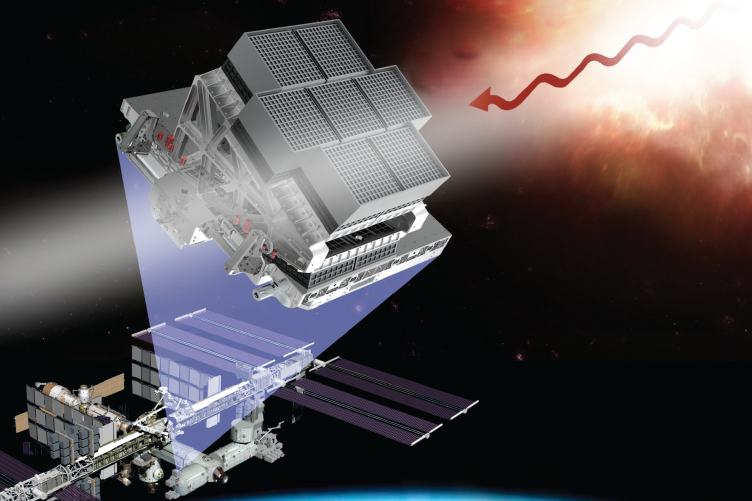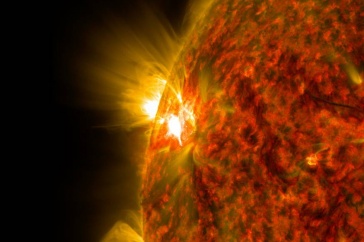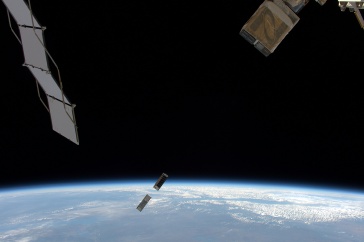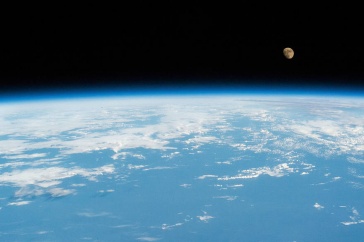
Illustration by the LEAP Collaboration Team.
From far outside the Milky Way Galaxy, massive star supernovas that spectacularly implode to form neutron stars and black holes release intense bursts of gamma ray radiation. NASA has awarded $750,000 to a team of UNH researchers to take a closer look at these distant phenomena to better understand the nature of gamma ray bursts, which represent some of the largest and most distant releases of energy in the known universe.
NASA has selected science proposals from four teams — including one from UNH led by Mark McConnell, professor of physics and astronomy — to further develop their research objectives over the next nine months in what’s called a “mission concept study.” NASA will then select two of these projects to become the next astrophysics missions in NASA’s Explorer Program, with a launch targeted for 2027. If selected, the project would receive $80 million to conduct the mission.
“This mission will fill in one of the remaining gaps in our understanding of gamma ray bursts and help us to better understand the role that magnetic fields play in one of the most energetic phenomena that we know of in the universe,” McConnell notes.
"This mission will fill in one of the remaining gaps in our understanding of gamma ray bursts to help us understand the role that magnetic fields play in one of the most energetic phenomena that we know of in the universe."
With collaborators from around the world, most notably at the Southwest Research Institute (San Antonio, Texas), at NASA’s Marshall Space Flight Center (Huntsville, Alabama) and at the University of Alabama in Huntsville, the UNH-led team has proposed to design and build an instrument called LEAP (LargE Area burst Polarimeter). LEAP will attach to the International Space Station and record the bright flashes of gamma rays that come from faraway sources.
When a gamma ray burst occurs in the distant reaches of the universe, the energy release is focused into narrow beams of radiation. Scientists believe that magnetic fields at the site of those bursts are responsible for focusing the energy, but the details of that process are poorly understood. Those same magnetic fields also influence the polarization — the orientation of the vibrating electric fields — of the emitted radiation. LEAP will study the polarization of the gamma ray radiation that reaches the Earth, providing clues about the role of magnetic fields in the focused energy release of a gamma ray burst.
Mounting the LEAP technology on the International Space Station, as opposed to a scientific balloon study, will allow the team to gather longer-term – and more accurate — data sets to learn more about some of the most energetic phenomena in the universe.
LEAP was previously selected for a mission concept study in 2020, but ultimately was not chosen for flight. McConnell notes that since that time, the research team has retooled the proposal to address NASA’s concerns about the project’s perceived weaknesses, and the team now feels more confident in its approach.
McConnell, who also serves as the director for the Southwest Research Institute's Department of Earth, Oceans, and Space located on the UNH Durham campus, will work closely with UNH colleagues, including senior research scientist Jason Legere, assistant professor of physics Fabian Kislat, professor emeritus of physics Jim Ryan, and others from SwRI-EOS, over the next nine months to develop the full proposal for NASA.
“It’s exciting to have an opportunity to place some new technology on the Space Station,” McConnell adds. “This builds on UNH's long legacy of space science, and more specifically, astrophysics, and we’re feeling pretty good about this second shot.”
The UNH Institute for the Study of Earth, Oceans, and Space (EOS) is UNH's largest research enterprise, comprising six centers with a focus on interdisciplinary, high-impact research on Earth and climate systems, space science, the marine environment, seafloor mapping and environmental acoustics. With approximately 100 principal investigators managing more than 400 individual grant awards, and with annual expenditures exceeding $45 million, EOS fosters an intellectual and scientific environment that advances visionary scholarship and leadership in world-class and graduate education.
-
Written By:
Rebecca Irelan | Institute for the Study of Earth, Oceans, and Space | rebecca.irelan@unh.edu | 603-862-0990



















































